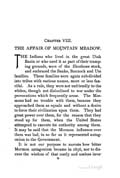
[p. 73]
CHAPTER VIII.
THE AFFAIR OF MOUNTAIN MEADOW.
THE Indians who lived in the great Utah Basin or who used it as part of their tramping grounds, were of the Shoshone stock, and embraced the Snake, Bannock and Ute families. These families were again sub-divided into tribes with various names, more or less fanciful. As a rule, they were not unfriendly to the whites, though not disinclined to war under the provocations which frequently arose. The Mormons had no trouble with them, because they approached them as equals and without a desire to force their civilization upon them. They had great power over them, for the reason that they stood up for them, when the United States attempted to execute its authority among them. It may be said that the Mormon influence over them was bad, in so far as it represented antagonism to the Government.
It is not our purpose to narrate how bitter
Mormon antagonism became in 1856, nor to
discuss the wisdom of that costly and useless inva-
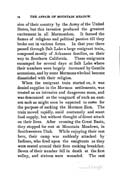
[p. 74]
sion
of their country by the Army of the United States, but this invasion produced the greatest excitement in all Mormondom. It fanned the flames of religious and political passion till they
broke out in various forms. In that year there
passed through Salt Lake a large emigrant train,
composed mostly of Arkansas families, on their
way to Southern California. These emigrants
encamped for several days at Salt Lake where their numbers were largely increased by Gentile
accessions, and by some Mormons who had become
dissatisfied with their religion.
When the emigrant train started on, it was
denied supplies in the Mormon settlements, was
treated as an intrusive and dangerous mass, and
was denounced as the vanguard of such an
eastern mob as might soon be expected to come for
the purpose of sacking the Mormon Zion. The
train moved rapidly, amid contumely and scant
food supply, but without thought of direct attack
on their lives. After crossing the Great Basin,
they stopped for rest at Mountain Meadows, in
Southwestern Utah. While enjoying their rest
here, their camp was suddenly attacked by
Indians, who fired upon the emigrants as they
were seated around their fires cooking breakfast.
Seven of their number fell in death at the first
volley, and sixteen were wounded. The rest
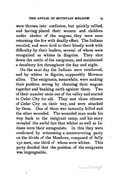
[p. 75]
were thrown into confusion, but quickly rallied,
and having placed their women and children
under shelter of the wagons, they were soon
returning the fire with deadly effect. The Indians
recoiled, and were held to their bloody work with
difficulty by their leaders, several of whom were
recognized as whites in disguise. They shot
down the cattle of the emigrants, and maintained
a desultory fire throughout the day and night.
On the next day the Indians were reinforced, and by whites in diguise, supposably Mormon allies. The emigrants, meanwhile, were making their position strong by chaining their wagons together and banking earth against them. Two of their number stole out of the valley and started to Cedar City for aid. They met three citizens of Cedar City on their way, and were attacked by them. One of them was instantly killed and the other wounded. The wounded man made his way back to the emigrant camp, and his story revealed the awful fact that whites as well as Indians were their antagonists. In this they were confirmed by witnessing a manoeuvering party on the divide of the Meadows, composed of fully 250 men, one third of whom were whites. This party decided that the position of the emigrants was impregnable.

[p. 76]
But, surrounded as they were, escape was out
of the question. Surrender must be a matter of
only a few days. A council of Mormons had
been held and it was agreed that the emigrants
should be decoyed from their stronghold and
exterminated. Lee and Bateman, two Mormon
leaders, approached the camp with a flag of truce.
Lee represented to the emigrants that the Indians
were very excited and bent on massacre, but that
he had gotten them to promise they would injure
no one who surrendered to the Mormons.
Believing that the Mormons would protect them, the
surrender was made. The men were to march
out unarmed, each one with a Mormon by his
side, to make the Indians believe he was a captive.
The wagons, loaded with food, sick and wounded
were to go ahead. The women and children were
to follow. The procession passed over the divide
in the Meadows and down the slope beyond. A
Mormon leader, Higbee, is there with a company
of militia. His appearance is assuring, for his
company may prove a source of protection in case
the Indians renew hostilities. But in a
twinkling his company wheels, and each member aims
for the emigrant nearest him. Flash go their
rifles in concert and down drop the victims of
their bullets. The Indians rush from their
ambush and dash with yells upon the women. The
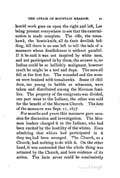
[p. 77]
horrid work goes on upon the right and left, Lee
being present everywhere to see that the
extermination is made complete. The rifle, the
tomahawk, the bowie-knife, all do their devilish
bidding, till there is no one left to tell the tale of a
massacre whose fiendishness is without parallel.
If it be said it was not inspired by white men,
and not participated in by them, the answer is, no
Indian could be so hellishly malignant, however
much he might be a tool and dupe. The men all
fell at the first fire. The wounded and the
women were brained with tomahawks. Some 18
children, too young to babble as witnesses, were
taken and distributed among the Mormon
families. The property of the emigrants was divided,
one part went to the Indians, the other was sold
for the benefit of the Mormon Church. The date
of the massacre was Sept. 11, 1857.
For months and years this massacre gave
occasion for discussion and investigation. The
Mormon leaders charged it to the Indians, who had
been excited by the hostility of the whites. Even
admitting that whites had participated in it
they too had been wronged. The Church, as a
Church, had nothing to do with it. On the other
hand, it was contended that the whole thing was
actuated by the Church, and bore evidence of its
action. The facts never could be conclusively
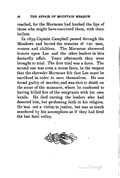
[p. 78]
reached, for the Mormons had hushed the lips of
those who might have convicted them, with their
bullets.
In 1859 Captain Campbell passed through the Meadows and buried the remains of 120 men, women and children. The Mormons showered honors upon Lee and the other leaders in this dastardly affair. Years afterwards they were brought to trial. The first trial was a farce. The second one was even a worse farce, in the respect that the shrewder Mormons felt that Lee must be sacrificed in order to save themselves. He was found guilty of murder, and was shot to death on the scene of the massacre, where he confessed to having killed five of the emigrants with his own hands. He died cursing the leaders who had deserted him, but professing faith in his religion. He was not a victim to justice, but was as much murdered by his accomplices as if they had fired the last fatal volley.